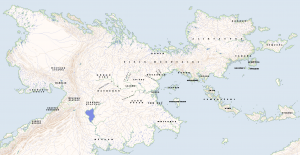Xšalad
Xšalad is a large region in Peilaš, to the southwest of the Edastean sphere and the Aiwa valley. In a narrow sense, the name is used only for the nation of the Xšali; in a broader sense Xšalad may also refer to the whole plain along the southern coast of northeastern Peilaš.
Xšalad, or more specifically the floodplain of the great Yima river that flows south from the Tjakori inland sea, has been the original, oldest locus of civilization on Akana. Agriculture was developed here as early as -7000 YP. Around -2500 YP the Old Kingdom was established; however, we know little of this period, and almost nothing about earlier times. It seems likely that this culture had writing early on, possibly around the same time as the Ngauro developed their writing system, but they did not use a durable medium and so their records are lost in the mists of time.
What we can say is that around -2100 YP the area was overrun by !Ho-speaking tribes from the southwest, who were darker-skinned than the original inhabitants and completely replaced the native language(s) and much of their culture. Over the course of the following two millennia, these invaders (known as the Xšali) set up three different empires that each controlled a great deal of territory, mostly to the north and east of the Yima floodplain. The three empires were separated by substantial interregna during which central control was lost and the provinces were left to fend for themselves, having to cope with the invasion of nomadic Western tribes from the Tjakori plateau.
From approximately -400 through -100 YP, the late 2nd Xšali Empire reached its peak. An overwhelmingly successful society flourished, creating wonders of engineering previously undreamed of, such as its iconic elevated cities and a vast Imperial highway network. Among these was the capital city's extremely advanced plumbing for that era, relying on a system of waterwheel-driven waterscrews to lift river water 50 meters to the peak of the city. This fed fountains, public baths, and gravity-operated sewers. It was the most sanitary city of the age, and the system remained unmatched on Akana until the technological era.
By 300 YP, the 3rd Xšali Empire is known to have had diplomatic relations with Huyfárah and the Empire of Athalē. At that time it was generally strong and successful, and trade flourished, but it was also ruled by an oligarchy of warlords and troubled by economic overextension. Much of the resources of the realm were expended on keeping its own territory under control. In 389 YP Xšalad was unable to repel a major invasion by Athalē and lost control of the Tjakori plateau, a substantial blow both to the economy and to national pride.
In classical times the larger Xšalad area between the Yima valley and the Mrisaŋfa peninsula was inhabited by a number of major ethnolinguistic groups: broadly speaking, from west to east the peoples living there speak Xšali; related !Ho languages; numerous languages unrelated to !Ho or Peninsular; and finally Peninsular languages.
